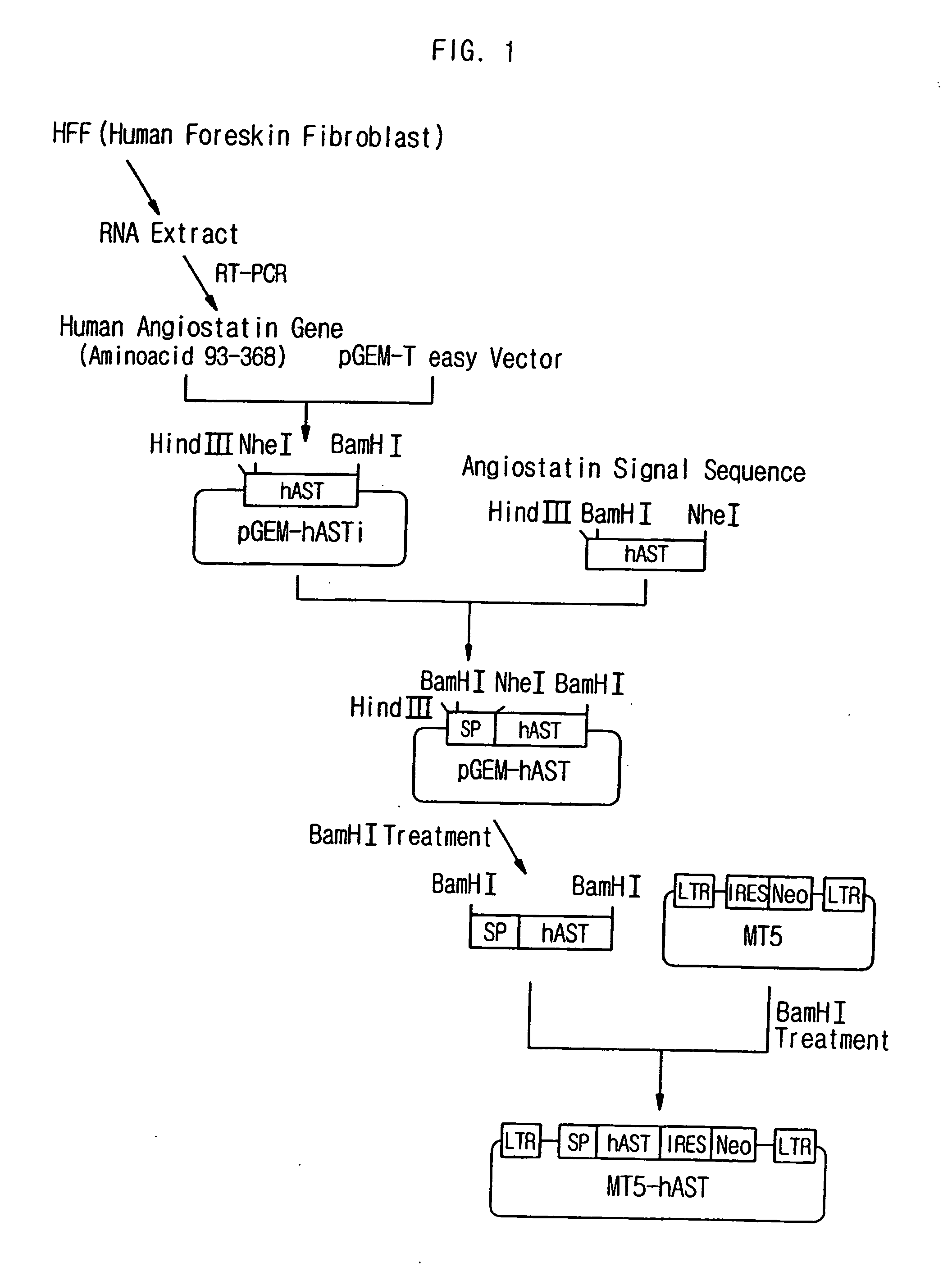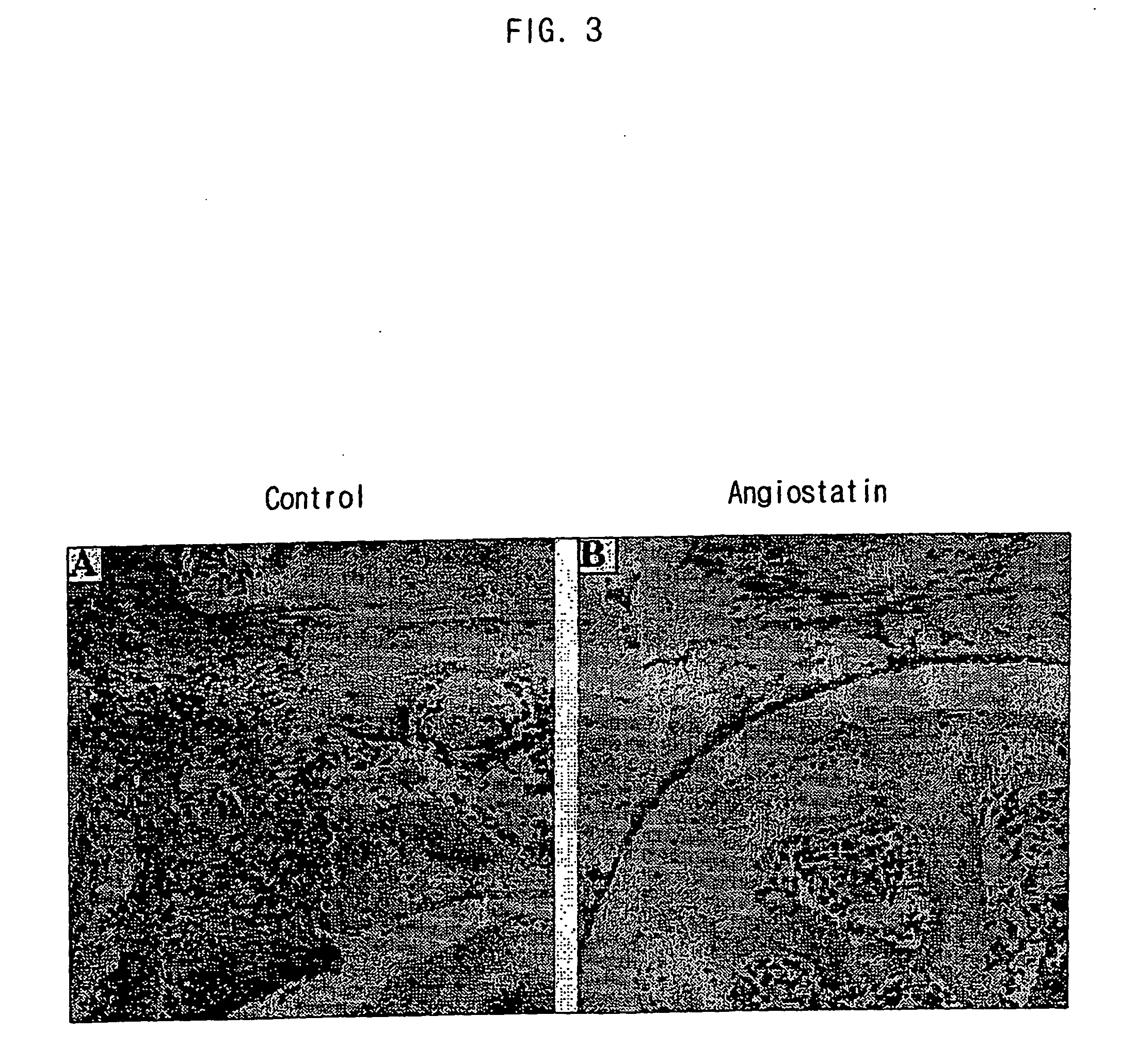Compositions for gene therapy of rheumatoid arthritis including a gene encoding an anti-angiogenic protein or parts thereof
a technology of rheumatoid arthritis and gene therapy, which is applied in the direction of peptide/protein ingredients, application, peptide sources, etc., can solve the problems of limited improvement of patients' condition, limited efficacy of developed drugs, economic loss as well as severe pain, etc., and achieves a remarkably reduced frequency of il-1 and significant level of il-1. , the effect of reducing the swelling level in the knee joint area
- Summary
- Abstract
- Description
- Claims
- Application Information
AI Technical Summary
Benefits of technology
Problems solved by technology
Method used
Image
Examples
example 1
Construction of Retroviral Vector Introduced with a Gene Encoding an Anti-Angiogenic Protein
[0050] (1-1) Construction of Retroviral Vector Introduced with Human Angiostatin Gene
[0051] (1-1-1) Cloning of Human Angiostatin Gene (Construction of pGEM T Easy-hASTi Vector)
[0052] Human angiostatin gene was cloned by extracting RNA from the human foreskin fibroblast (HFF), obtaining cDNA, and performing PCR. First, RNA was extracted from the HFF cells by using the Tryzol method (Gibco BRI, USA), and cDNA was obtained from the extracted RNA by using reverse transcriptase polymerization reaction. Then, a DNA fragment including human angiostatin gene was obtained through the PCR by using the cDNA as a PCR template and the synthetic nucleotides represented by SEQ. ID. NO: 3 and SEQ. ID. NO: 4 as primers. To perform the PCR, total 100 μl of a mixture solution was prepared by mixing 1 μl of template DNA, each of 1 μl of 10 pmol / μl primer, 10 μl of 10 mM dNTP, 35 units of Expand high fidelity ...
example 2
Preparation of Cell Lines Expressing Anti-Angiogenic Protein
[0065] (2-1) Preparation of Cell Lines Expressing Human Angiostatin
[0066] In order to prepare cell lines expressing human angiostatine, the retrovirus including the MT5-hAST vector was produced. At first, the MT5-hAST vector DNA prepared in the example (1-1-2) described above was transfected into 293 T cells with the plasmid (retrovirus packaging kit ampho catalogue #6161; TAKARA SHUZO CO., LTD., SHIGA, Japan) expressing gag-pol and env gene of murine leukemia virus (MLV) and after 8 hrs, new culture medium was exchanged. After 48 hrs, the cell culture medium was filtered with 0.45 μm of filter paper to obtain noncellular virus.
[0067] The produced MT5-hAST retrovirus was transduced into NIH3T3 cells (ATCC CRL1658), and then the cells were treated with G418 (1 μg / μl, Gibco BRL, USA) for 14 days after 24 hrs to select and cultivate the cell lines introduced with the retrovirus. Collecting the group of cells selected and cu...
example 3
Efficacy of Gene Therapy Using Anti-Angiogenic Factors in Mouse Collagen-Induced Arthritis Model
[0072] (3-1) Preparation of Mouse Collagen-Induced Arthritis Model
[0073] Mouse collagen-induced arthritis (CIA) model is an autoimmune type of arthritis model which shows many characteristics in common with human rheumatoid arthritis. The collagen-induced arthritis model was prepared by the following method. DBA / 1 mice (Jackson Laboratory, Maine, USA), aged 9-10 weeks at the start of experiments, were immunized intradermally at the base of the tail with bovine type II collagen (100 μg; Chondrex, Wash., USA) emulsified in Freund's complete adjuvant (Gibco BRL, NY, USA). On day 21, the animals were boosted with an intradermal injection of 100 μg type II collagen. Gradual onset of arthritis normally starts approximately 4 weeks after initial immunization. In this example, mice that did not yet have any macroscopic signs of arthritis were chosen at 30 days after the initial immunization to ...
PUM
| Property | Measurement | Unit |
|---|---|---|
| reduction | aaaaa | aaaaa |
| area | aaaaa | aaaaa |
| volume | aaaaa | aaaaa |
Abstract
Description
Claims
Application Information
 Login to View More
Login to View More - R&D
- Intellectual Property
- Life Sciences
- Materials
- Tech Scout
- Unparalleled Data Quality
- Higher Quality Content
- 60% Fewer Hallucinations
Browse by: Latest US Patents, China's latest patents, Technical Efficacy Thesaurus, Application Domain, Technology Topic, Popular Technical Reports.
© 2025 PatSnap. All rights reserved.Legal|Privacy policy|Modern Slavery Act Transparency Statement|Sitemap|About US| Contact US: help@patsnap.com



